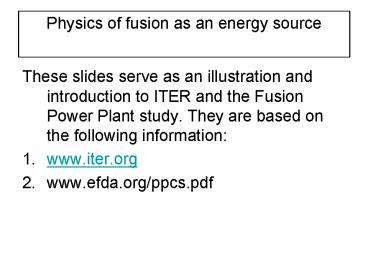Physics of fusion as an energy source PowerPoint PPT Presentation
1 / 33
Title: Physics of fusion as an energy source
1
Physics of fusion as an energy source
- These slides serve as an illustration and
introduction to ITER and the Fusion Power Plant
study. They are based on the following
information - www.iter.org
- www.efda.org/ppcs.pdf
2
Central Solenoid
Blanket Module
Vacuum Vessel
Outer Intercoil Structure
Cryostat
Toroidal Field Coil
Port Plug (IC Heating)
Poloidal Field Coil
Divertor
Machine Gravity Supports
Torus Cryopump
3
ITER Objectives
- Programmatic
- Demonstrate the scientific and technological
feasibility of fusion energy for peaceful
purposes. - Technical
- Demonstrate extended burn of DT plasmas, with
steady state as the ultimate goal. - Integrate and test all essential fusion power
reactor technologies and components. - Demonstrate safety and environmental
acceptability of fusion.
4
(No Transcript)
5
(No Transcript)
6
(No Transcript)
7
ITER Parameters
- Total fusion power 500 MW (700MW)
- Q fusion power/auxiliary heating power 10
(inductive) - Average neutron wall loading 0.57 MW/m2 (0.8
MW/m2) - Plasma inductive burn time 300 s
- Plasma major radius 6.2 m
- Plasma minor radius 2.0 m
- Plasma current (inductive, Ip) 15 MA (17.4 MA)
- Vertical elongation _at_95 flux surface/separatrix 1
.70/1.85 - Triangularity _at_95 flux surface/separatrix 0.33/0
.49 - Safety factor _at_95 flux surface 3.0
- Toroidal field _at_ 6.2 m radius 5.3 T
- Plasma volume 837 m3
- Plasma surface 678 m2
- Installed auxiliary heating/current drive
power 73 MW (100 MW)
8
Burning Plasma
- For power amplification Q gt5, a-articles become
the dominant source of plasma heating and
determine plasma behaviour - conditions cannot be reached by present machines
or by upgrades, nor satisfactorily simulated. - New physics situations must be explored
experimentally - self-heating by isotropic high energy particles
- particle transport, MHD stability linked with a
-particle dominance - corroboration/calibration of dimensionless
scaling relationships - Technical demands from size, heat removal and
neutron flux - non-linear process leading immediately to large
power - design impact of shielding
- Only tokamaks are ready for this step, but
results are transferable to any magnetic
confinement scheme for fusion.
9
ITER History
The idea for ITER originated from the Geneva
superpower summit in November 1985 where Premier
Gorbachov, following discussions with President
Mitterand of France, proposed to President Reagan
that an international project be set up to
develop fusion energy for peaceful purposes. The
ITER-project subsequently began as a
collaboration between the former Soviet Union,
the USA, the European Union (via Euratom) and
Japan. In 1988 the conceptual design work was
started, followed in 1992 by engineering design.
On July 21st, 2001, the ITER engineering design
activities were successfully completed, and the
final design report was made available to the
ITER Parties.
10
(No Transcript)
11
(No Transcript)
12
(No Transcript)
13
(No Transcript)
14
(No Transcript)
15
(No Transcript)
16
(No Transcript)
17
(No Transcript)
18
(No Transcript)
19
(No Transcript)
20
(No Transcript)
21
Reactor studies
22
(No Transcript)
23
(No Transcript)
24
(No Transcript)
25
(No Transcript)
26
(No Transcript)
27
(No Transcript)
28
(No Transcript)
29
safety
- extremely low levels of fuel inventory in the
burning chamber - --gt power production stops a few seconds after
fuelling is stopped. - low levels of residual power density (arising
from the decay of activated materials) in
structure after the termination of burn. - If a total loss of active cooling were to
occur during the burn, the plasma would switch
off passively due to impurity influx deriving
from temperature rises in the walls of the
reaction chamber. - Any further temperature increase in the
structures, due to residual decay heat, cannot
lead to melting. This result is achieved without
any reliance on active safety systems or operator
actions.
30
safety
The maximum radiological doses to the public
arising from the most severe conceivable accident
driven by in-plant energies (bounding accident)
would not exceed 18 mSv, below the level at which
evacuation would be considered in many national
regulations (50 mSv, the value which is also
recommended by the International Commission on
Radiological Protection
31
safety
The power plant will be designed to withstand
an earthquake with an intensity equal to that of
the most severe historical earthquake increased
by a safety margin, in accordance with the safety
design rules in force. It would also be possible
to provide any features that might be needed to
meet the non-evacuation criterion in case of
impact of a large aircraft. In case of fire, a
maximum of a few grams of tritium could be
released, by appropriate partitioning of the
tritium inventory, which is consistent with the
non-evacuation criterion. If there is
substantial use of beryllium as an in-vessel
component (approximately 560 tons are foreseen
within the blanket of model B), it may be
necessary to recycle it to satisfy the EU
legislation on beryllium chemical toxicity.
32
safety
The radiotoxicity of the materials (namely, the
biological hazard potential associated with their
activation) decays by a factor ten thousand over
a hundred years. All of this material, after
being kept in situ for some decades, will be
regarded as non-radioactive (contact dose rate
lower than 0.001 mSv/h, decay heat lower than 1
W/m3) or recyclable (contact dose rate lower than
20 mSv/h, decay heat lower than 10 W/m3). The
recycling of some material could require remote
handling procedures. An alternative could be a
shallow land burial, after a time (approximately
100 years) depending on the nuclides contained in
the materials and the local regulations. None
of the materials required are subject to the
provisions of non-proliferation treaties.
33
Cost of Electricity
coe is cost of electricity, A is the
availability, Eta_th is the thermodynamic
efficiency, P_e is the net electric power,
Beta_N is the normalised plasma pressure,
Nn/nG is the Greenwald normalised plasma
density.

